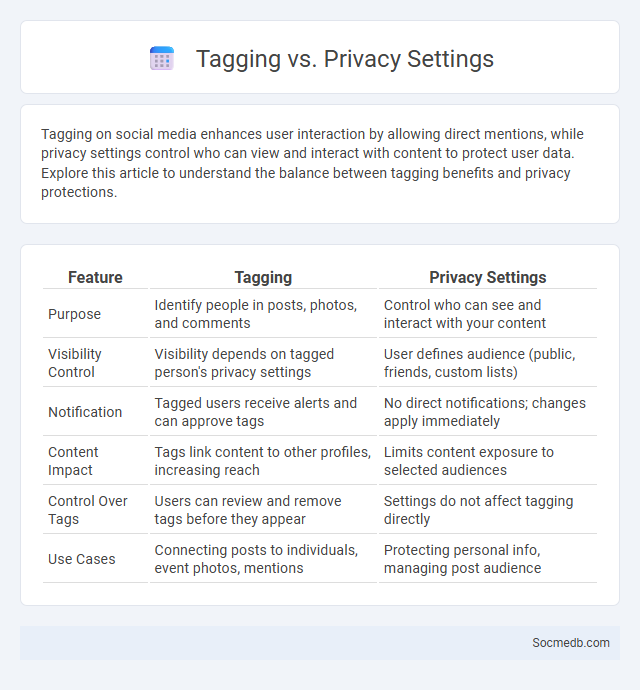
Photo illustration: Tagging vs Privacy Settings
Tagging on social media enhances user interaction by allowing direct mentions, while privacy settings control who can view and interact with content to protect user data. Explore this article to understand the balance between tagging benefits and privacy protections.
Table of Comparison
| Feature | Tagging | Privacy Settings |
|---|---|---|
| Purpose | Identify people in posts, photos, and comments | Control who can see and interact with your content |
| Visibility Control | Visibility depends on tagged person's privacy settings | User defines audience (public, friends, custom lists) |
| Notification | Tagged users receive alerts and can approve tags | No direct notifications; changes apply immediately |
| Content Impact | Tags link content to other profiles, increasing reach | Limits content exposure to selected audiences |
| Control Over Tags | Users can review and remove tags before they appear | Settings do not affect tagging directly |
| Use Cases | Connecting posts to individuals, event photos, mentions | Protecting personal info, managing post audience |
Understanding Tagging: Definition and Purpose
Tagging in social media is the process of identifying and linking specific users, brands, or topics within a post to enhance engagement and visibility. This feature allows users to connect content directly to relevant profiles, increasing reach and interaction through notifications and easy navigation. Tags help organize content contextually, facilitating discovery and fostering community building around shared interests or events.
What are Privacy Settings? Key Features Explained
Privacy settings on social media allow you to control who can see your posts, personal information, and activity. Key features include audience selection, profile visibility controls, and options to block or restrict users from viewing your content. Adjusting these settings helps protect your online presence and ensures your data is shared only with trusted connections.
Tagging vs Privacy Settings: Core Differences
Tagging on social media allows you to link your profile to posts or photos, increasing visibility and engagement, while privacy settings control who can see your content and personal information. You should carefully manage tagging preferences to avoid unwanted exposure and maintain control over your online presence. Understanding these core differences helps protect your digital identity while enjoying social interactions on various platforms.
The Role of Tagging in Social Media Platforms
Tagging enhances content discovery and user engagement by linking posts to relevant people, topics, or locations across social media platforms like Instagram, Facebook, and Twitter. It increases your content's visibility in search results and helps build communities around shared interests. Effective tagging strategies boost reach, foster interactions, and drive organic growth on social networks.
How Privacy Settings Control Your Online Presence
Privacy settings on social media platforms empower users to manage who can view their personal information, posts, and interactions, significantly influencing their online presence. Customizing these settings helps protect sensitive data from unauthorized access, reduces exposure to targeted advertising, and mitigates risks of identity theft or cyberbullying. By regularly updating privacy preferences, individuals maintain control over their digital footprint and shape how they are perceived by different audiences.
Managing Tagged Content: User Controls and Options
You have full control over managing tagged content on social media platforms, allowing you to review posts where you are tagged before they appear on your profile. Privacy settings enable customization options to approve, hide, or remove tags, ensuring your online presence reflects your preferences. Leveraging these tools helps maintain your digital reputation and enhances your overall social media experience.
Advantages and Risks of Tagging
Tagging on social media enhances your content's visibility by connecting posts to relevant people, locations, or topics, boosting engagement and expanding your audience reach. It facilitates networking opportunities and fosters community interaction but may also expose you to privacy concerns, unwanted attention, or misidentification. Being mindful of who and what you tag helps you manage your online reputation while leveraging the benefits of increased social connectivity.
Enhancing Security with Privacy Settings
Social media platforms offer advanced privacy settings that allow users to control who can access their personal information and posts, significantly reducing the risk of unauthorized data exposure. Features such as two-factor authentication, customizable friend lists, and activity visibility controls play a crucial role in safeguarding online identities. Regularly updating these settings ensures enhanced protection against cyber threats and maintains user privacy in dynamic digital environments.
Best Practices: Balancing Tagging and Privacy
Balancing tagging and privacy on social media requires careful consideration of both your audience and consent from those tagged. Use selective tagging to highlight relevant content while respecting individual privacy preferences and platform-specific settings. You can enhance your online presence by being mindful of privacy controls and ensuring that tags contribute positively to your digital identity.
Future Trends in Tagging and Privacy Management
Future trends in social media tagging will leverage AI and machine learning to enhance automated, context-aware identification, making it easier for you to manage content connections while preserving privacy. Privacy management tools are evolving to give users granular control over data sharing and visibility, incorporating blockchain and decentralized technologies to ensure transparency and security. These advancements aim to balance personalized experiences with robust protection of personal information, setting a new standard for social networking interactions.
 socmedb.com
socmedb.com